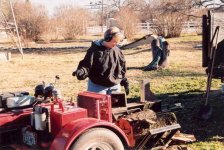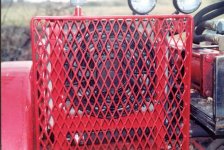You are using an out of date browser. It may not display this or other websites correctly.
You should upgrade or use an alternative browser.
You should upgrade or use an alternative browser.
Log splitter:
- Thread starter Crutches
- Start date
/ Log splitter:
#11
</font><font color="blue" class="small">( I agree that it might be nice to have the tractor free while splitting, but it is also nice to maintain one engine and simplify your life, )</font>
That's part of the pros/cons thing I eluded to earlier.
For my setup, my preference is just the opposite (and to use a stand alone unit). I leave the splitter at the wood pile and just go out and fire it up, split for awhile then shut it down. For the 3PH version, I'd have to remove the box blade (since it's the implement normally on the tractor), put the splitter on, go do my splitting then (as it always seems to go), switch back to the box blade. All those extra steps would probably make it such that I wouldn't just run out and split for an hour or 2 for something to do.
Maybe I'm lucky but I can get 15-20 years off a little 5hp Briggs or Honda on a splitter. I would rather put all the splitting hours on a $200 throw-away engine than my tractor.
Brian
That's part of the pros/cons thing I eluded to earlier.
For my setup, my preference is just the opposite (and to use a stand alone unit). I leave the splitter at the wood pile and just go out and fire it up, split for awhile then shut it down. For the 3PH version, I'd have to remove the box blade (since it's the implement normally on the tractor), put the splitter on, go do my splitting then (as it always seems to go), switch back to the box blade. All those extra steps would probably make it such that I wouldn't just run out and split for an hour or 2 for something to do.
Maybe I'm lucky but I can get 15-20 years off a little 5hp Briggs or Honda on a splitter. I would rather put all the splitting hours on a $200 throw-away engine than my tractor.
Brian
GaryBDavis
Gold Member
Most log splitters built with a dedicated engine/pump operate much faster than 3pt splitter because they use a "two stage" hydraulic pump. A 3pt splitter relies on the tractor's hydraulic pump which is more commonly a single stage design.
A two stage hydraulic pump works like this. It has two internal gears - high and low. The pump works in a high volume/low pressure mode until the output pressure rises to a set point (usually around 500 or 600 PSI). When that happens, the pump switches to a high pressure/low volume mode. The pump switches automatically and the user doesn’t really notice it. All of this is built internal to the pump and it doesn’t really look any different from a single stage pump.
On my home built log splitter, I run a 13HP Honda engine, 22GPM pump, and a 5”x30” cylinder. Under no load, the cylinder will travel out and back in under 13 seconds. I have a pressure gauge installed and I can tell by looking at it if it’s in high or low mode. I can also tell by how the cylinder is moving.
Because my cylinder is 5” in diameter, I get almost 13,000 pounds of force in the low pressure mode. The unit only switched into the high pressure mode when I hit a knot or with a very hard piece of wood. The result is I’m splitting in the “fast” mode most of the time. When it does shift into the high pressure mode, I get almost 60,000 pounds of force. It’s the best of both worlds.
A two stage hydraulic pump works like this. It has two internal gears - high and low. The pump works in a high volume/low pressure mode until the output pressure rises to a set point (usually around 500 or 600 PSI). When that happens, the pump switches to a high pressure/low volume mode. The pump switches automatically and the user doesn’t really notice it. All of this is built internal to the pump and it doesn’t really look any different from a single stage pump.
On my home built log splitter, I run a 13HP Honda engine, 22GPM pump, and a 5”x30” cylinder. Under no load, the cylinder will travel out and back in under 13 seconds. I have a pressure gauge installed and I can tell by looking at it if it’s in high or low mode. I can also tell by how the cylinder is moving.
Because my cylinder is 5” in diameter, I get almost 13,000 pounds of force in the low pressure mode. The unit only switched into the high pressure mode when I hit a knot or with a very hard piece of wood. The result is I’m splitting in the “fast” mode most of the time. When it does shift into the high pressure mode, I get almost 60,000 pounds of force. It’s the best of both worlds.
Attachments
Tim_in_IA
Platinum Member
- Joined
- Feb 14, 2005
- Messages
- 830
- Location
- Eastern Iowa
- Tractor
- Kubota B7610HSD, Mahindra 6500 4WD, JD 440ic crawler, 2 560 farmalls.
now that's a good reason to get a dedicated splitter. 2 stage pump sounds good to me. I wonder if any of the pto pumps have this capability? Thanks for this information!
Foghorn
New member
Gary, I've been thinking of building my own 3pt splitter that would work off the PTO. The pump I was looking at (22gpm) stated that it required a tank of equal or greater capacity as the pump. In other words the tank would have to be at least 22gallons. I don't understand why because when I looked at Timberwolf's PTO splitters their tanks were 9.5 and 15 depending on the model. Since I really know nothing about splitters can you recommend a good free source of parts etc... before I go sinking any $$ into this project?
Grant1
Bronze Member
I bought a 3 point splitter from Northern Tool for 549.00 It works off the tractors remote hydraulics. They are currently on sale for 499.00 You will have to buy the hoses with quick disconnects to attach it to the tractor. First splitter Ive had besides an ax but seems to do a good job and plenty fast enough attached to a Kioti CKk30
GaryBDavis
Gold Member
There is a general rule of thumb that says your tank should be close to the size of your pump (22 gallon tank for 22 GPM pump). The main reason behind this rule is to keep the hydraulic oil from getting too hot. The pump can get pretty hot and the hydraulic oil takes on a lot of this heat as is circulated. If your oil circulates too quickly, it will not have enough time to cool down.
For a typical hydraulic system, you need to keep the temperature below 150 degrees Fahrenheit. Any hotter and it will start to damage the seals in the pump and valves. However, the optimum operating temperature is around 120 degrees so you want it to warm up somewhat.
I think my tank is a 12 or 15 gallon size. I have thermometer in the tank so I can watch it. I found out that on a hot summer day here in central Texas, I get 30 to 45 minutes before the oil gets too hot. So I have to take a break and let it cool down. Since then, I’ve added a hydraulic oil cooler with an electric fan that is controlled by a thermostat. It’s much like a small transmission oil cooler only it’s made for hydraulic applications and is matched to handle the 22GPM flow of my system. I got the 12VDC fan at a hot rod shop. The thermostat is mounted in the tank to measure the oil temperature directly. It turns the fan on at 130 and off at 120.
I did most of my shopping at Northern Hydraulics which has now changed their name to Northern Tool. They carry a decent line of pumps, mounting brackets, couplers, cylinders, etc. The oil cooler came from Graingers. I had my hoses custom made at a local hydraulic hose shop. I had them connectorized at one end only and cut a bit long. From there, I dressed them in and marked the end of the hose. I then took the hoses back to the hose shop and had them connectorize the remaining end.
Hydraulics are a lot of fun.
For a typical hydraulic system, you need to keep the temperature below 150 degrees Fahrenheit. Any hotter and it will start to damage the seals in the pump and valves. However, the optimum operating temperature is around 120 degrees so you want it to warm up somewhat.
I think my tank is a 12 or 15 gallon size. I have thermometer in the tank so I can watch it. I found out that on a hot summer day here in central Texas, I get 30 to 45 minutes before the oil gets too hot. So I have to take a break and let it cool down. Since then, I’ve added a hydraulic oil cooler with an electric fan that is controlled by a thermostat. It’s much like a small transmission oil cooler only it’s made for hydraulic applications and is matched to handle the 22GPM flow of my system. I got the 12VDC fan at a hot rod shop. The thermostat is mounted in the tank to measure the oil temperature directly. It turns the fan on at 130 and off at 120.
I did most of my shopping at Northern Hydraulics which has now changed their name to Northern Tool. They carry a decent line of pumps, mounting brackets, couplers, cylinders, etc. The oil cooler came from Graingers. I had my hoses custom made at a local hydraulic hose shop. I had them connectorized at one end only and cut a bit long. From there, I dressed them in and marked the end of the hose. I then took the hoses back to the hose shop and had them connectorize the remaining end.
Hydraulics are a lot of fun.
Attachments
Knight9
Veteran Member
I'm kind of an impatient guy when it comes to splitting wood. /forums/images/graemlins/blush.gif I like the faster cycle times. So the splitter I went for does not use hydraulics and has a cycle time of probably under 3 seconds. It will keep you hoppin'
Highly recommend looking at all alternatives.
Kevin
Highly recommend looking at all alternatives.
Kevin
rozett
Platinum Member
- Joined
- Mar 23, 2002
- Messages
- 718
- Location
- Maine
- Tractor
- Cub Cadet 7360SS & Craftsman GT3000 23 HP w/50
While I understand not wanting to have another motor to maintain, I gotta tell you.... in 100 cord of wood, the only maintenance I needed to do was change the oil, the air filter, and hydraulic filter just once. Not really a lot of work.


